APRIL FOOLISHNESS
The Great April Fool’s Day
COMICS SWITCHEROO of 1997
It was an absolutely delicious idea. Get syndicated cartooners to draw another cartoonist’s comic for a little sneaky comic relief. The idea was the brain infant of Rick Kirkman and Jerry Scott who produce the comic strip Baby Blues (Scott writes it; Kirkman draws it), and Scott is the one who describes the conception and birth of the scheme, herewith—:
ABOUT SIX YEARS AGO, Rick Kirkman and I shared an office in downtown Phoenix where we worked on getting our comic strip, Baby Blues, started. (It began, eventually, on January7, 1990.) On one of those afternoons when deadlines were looming and time was slipping by, we (naturally) were sitting around talking about everything but our own comic strip. The thought came up that it would be kind of neat to see a newspaper comics page where all the cartoonists switched strips and panels for one day. It was a simple idea with no real purpose (which is why it took a couple of cartoonists to think of it), and we went back to work.
The idea kept resurfacing over the years, but nothing was ever done about it because the thought of organizing such a thing was too intimidating. Getting a bunch of cartoonists pointed in the same direction to accomplish a common goal on time seemed about as appealing as driving a herd of cats from Kansas City to Tucson. But then last summer Rick read an interview in which Gary Larson said that if he had a chance to draw another feature for one day, it would be Family Circus.
It was a funny thought, and reminded us of our Switcheroonie idea, so Rick phoned Bil Keane and asked if he’d be interested in participating in such a venture if we made it an April Fool’s joke on comic readers. [Why Bil Keane? Dunno. Perhaps because Keane was the usual master of ceremonies sat the Reuben Banquet during the annual convention of the National Cartoonists Society. That and maybe because Keane lived in the same city Kirkman and Scott lived in—Phoenix. But I’m only guessing, and why they phoned Keane isn’t material to the story anyhow.—RCH]
Bil said that he’d be glad to play along, so armed with his enthusiastic support, we started calling other cartoonists to test the idea out on a broader base. After nearly a nearly unanimous reception (cartoonists are usually unanimously in favor of anything that someone else is going to do the work on), we drafted a letter and sent it out to the 100 or so syndicated cartoonists who were members of the National Cartoonists Society.
The letter explained the concept and asked the recipient to list his/her top ten choices of features he/she might like to draw for release on April First. [They also alerted the syndicates to the scheme and got their support.]
In order to be as efficient as possible and to save precious time, Rick decided to computerize the response with some new software he found. Naturally, with such high-tech help, the entire process of matching cartoonists up with one of their top ten choices ended up taking roughly five times longer than it should have if we’d used a handful of index cards and a bulletin board. The matching-up process also would have taken much less time if we had simply let everyone draw their first choice. And, in retrospect, it might have been funnier to open the paper on April First and see forty-six different versions of Dilbert.
After a few weeks of agony (mostly for Rick since all of this was on his computer), the match-ups were complete, and we sent out the assignments with careful instructions for the cartoonists to follow, and much of the next few weeks were taken up with fielding phone calls re-explaining the whole thing to cartoonists who don’t read careful instructions.
After a ton of telephone interviews (thanks to all the cartoonists who took time out of their schedules to help field some of these), the Switcheroonie went off without a hitcheroonie. The results were funny, readers got an unexpected treat, and the comics got a little publicity for a change. All in all, not a bad outcome.
And—no, we’re not going to do it again next year.
JUD HURD PUBLISHED some (perhaps all) of the April Foolish strips in his quarterly magazine, Cartoonist PROfiles No.114 (June 1997), and we’re posting what he published herewith. But first, a little guidance.
The format for comic strips lists the strip title first, then the creator of the strip, then the syndicate, and then the name of the April Fool (and his feature’s name in parentheses). The arrangement for panel cartoons is a little less predictable. The panel’s name and the name of its creator and syndicate are right there, where they ought to be. But the April Fool’s name (and his feature’s name) pop up in a variety of places—usually below the panel, but not always. But we’re sure you can find that with a little looking, so get at it—enjoy.
As part of your enjoyment, you’ll note that sometimes the “guest cartoonist” refers to his own comic strip as the punchline in the strip he’s guesting on. In Beetle Bailey, for instance, guest cartooner Jeff MacNelly concludes the strip with a character from his Shoe strip, the youngster. And similarly, in Hi and Lois, guest cartooner Greg Evans includes his Luann in the last panel as the punchline.
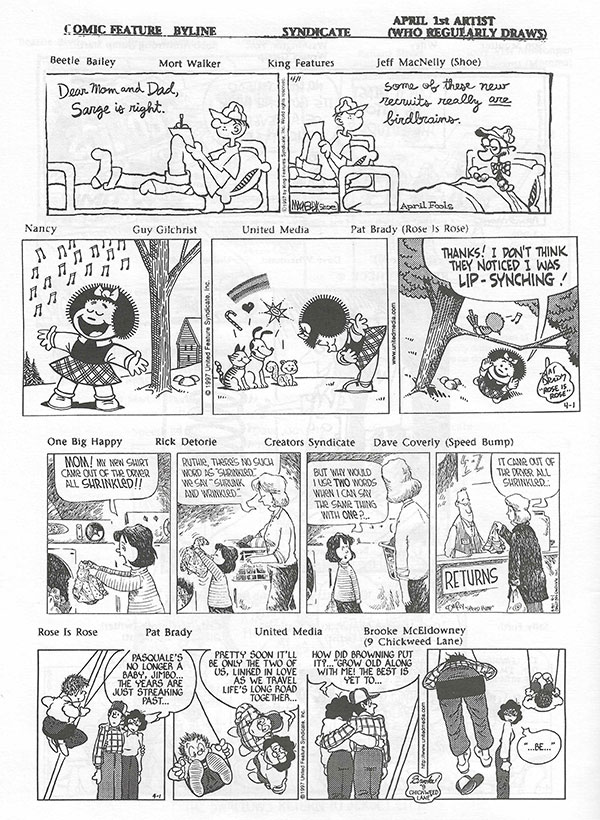 |
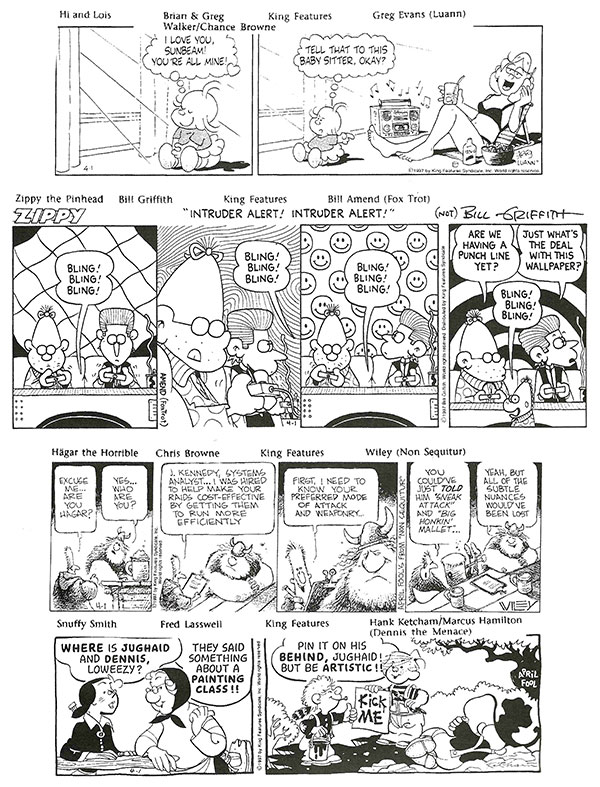 |
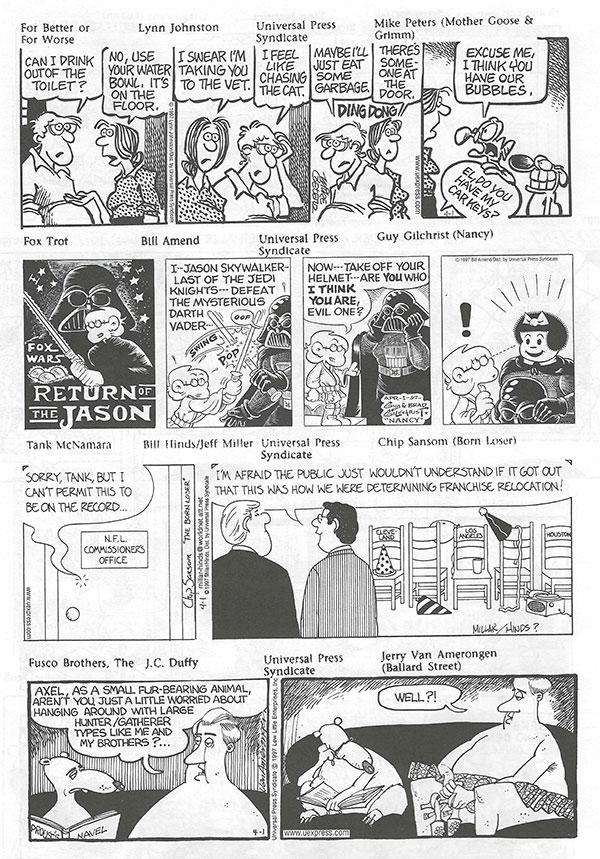 |
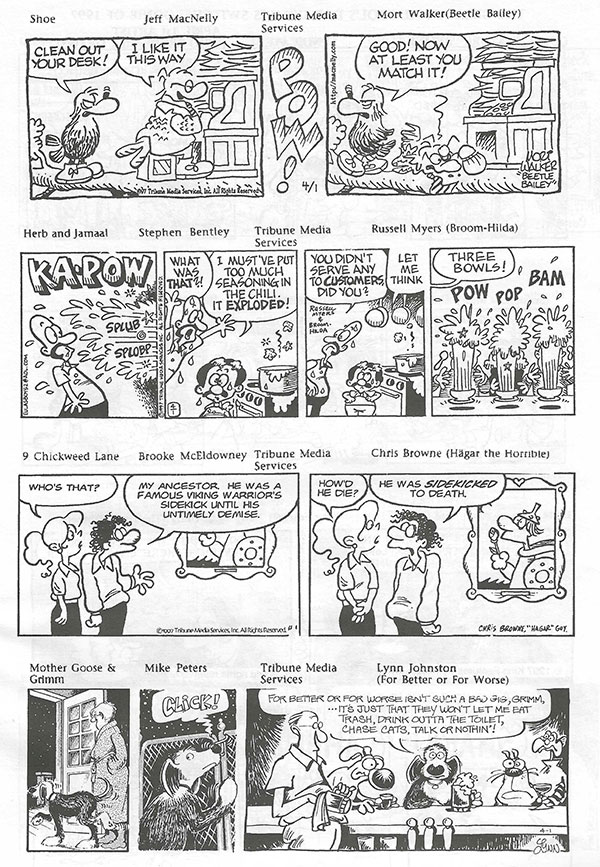 |
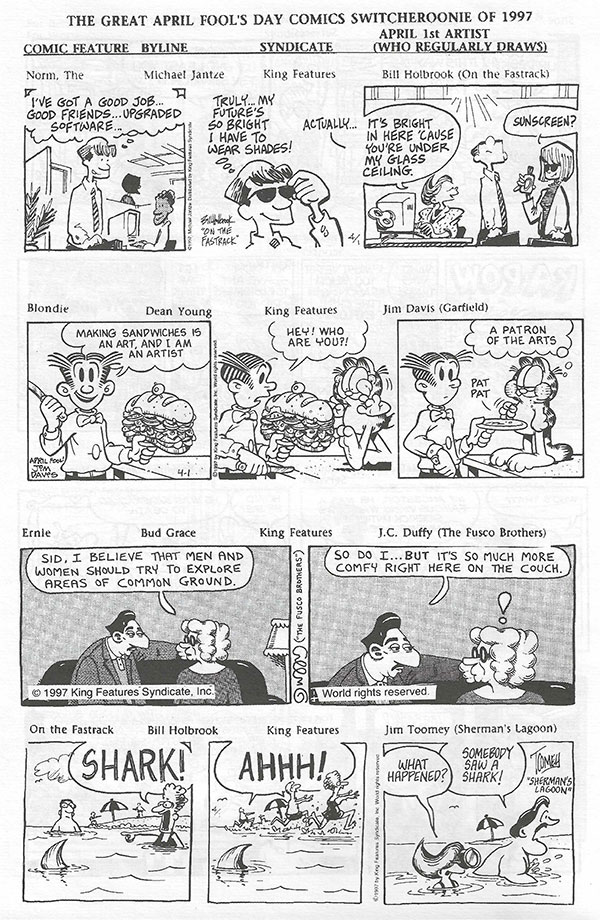 |
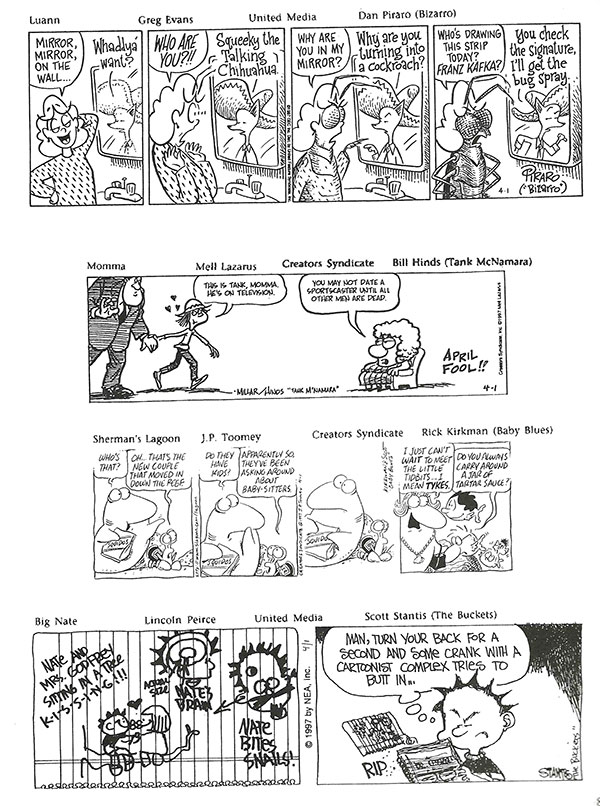 |
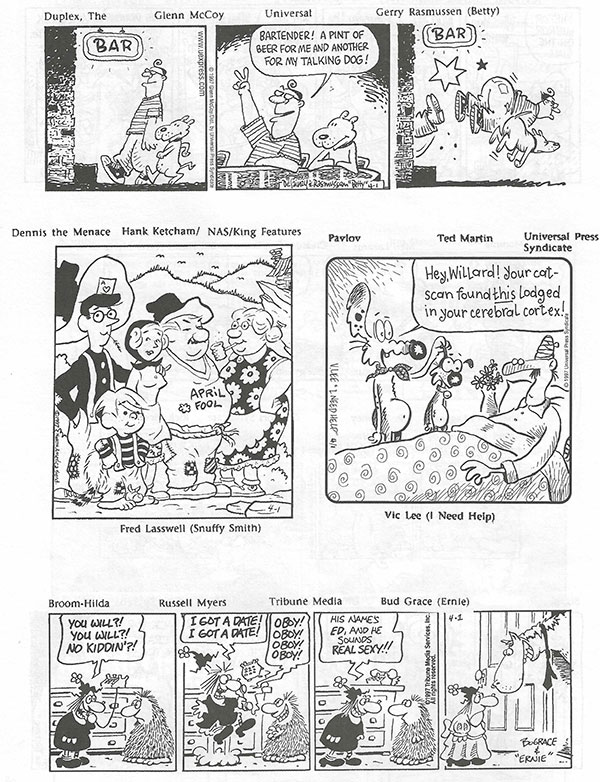 |
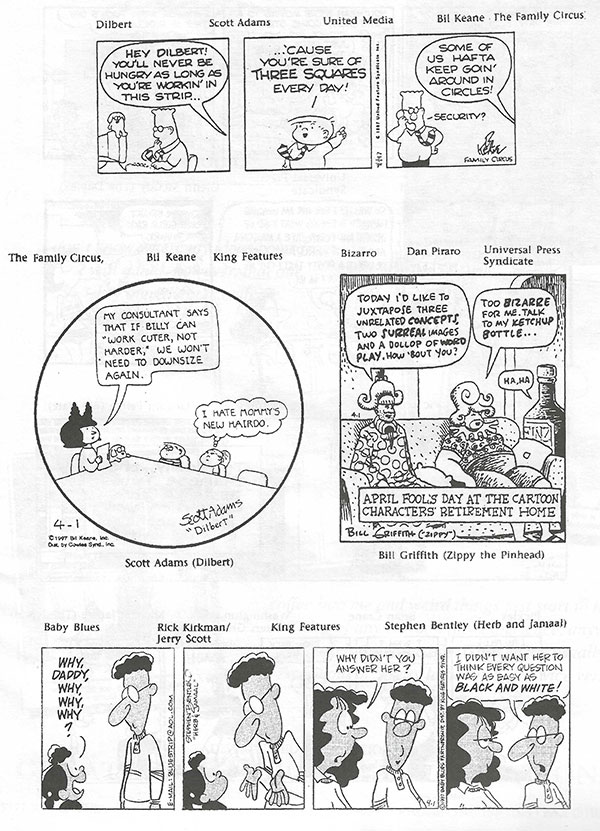 |
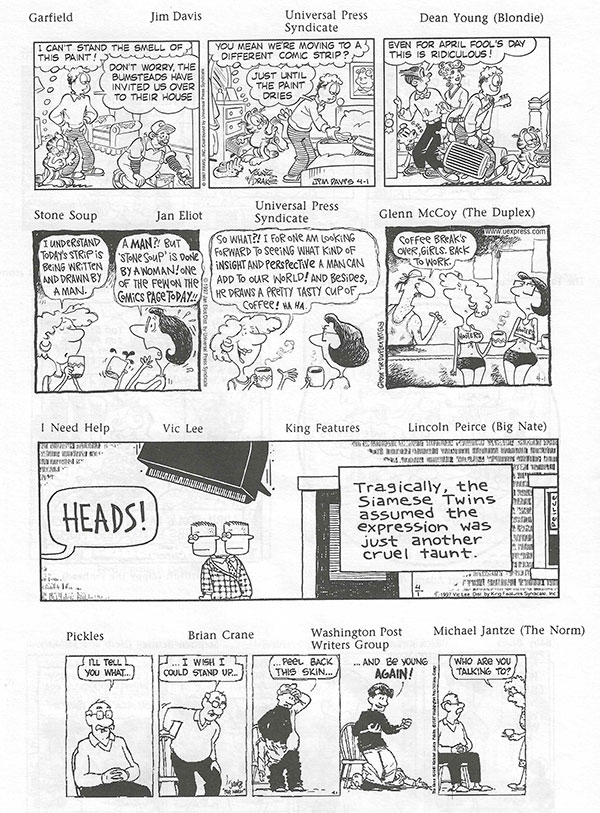 |
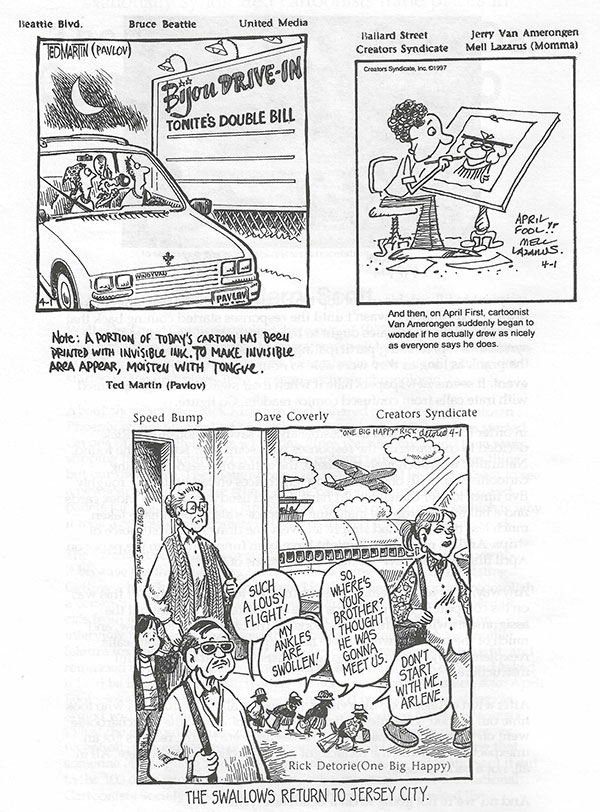 |
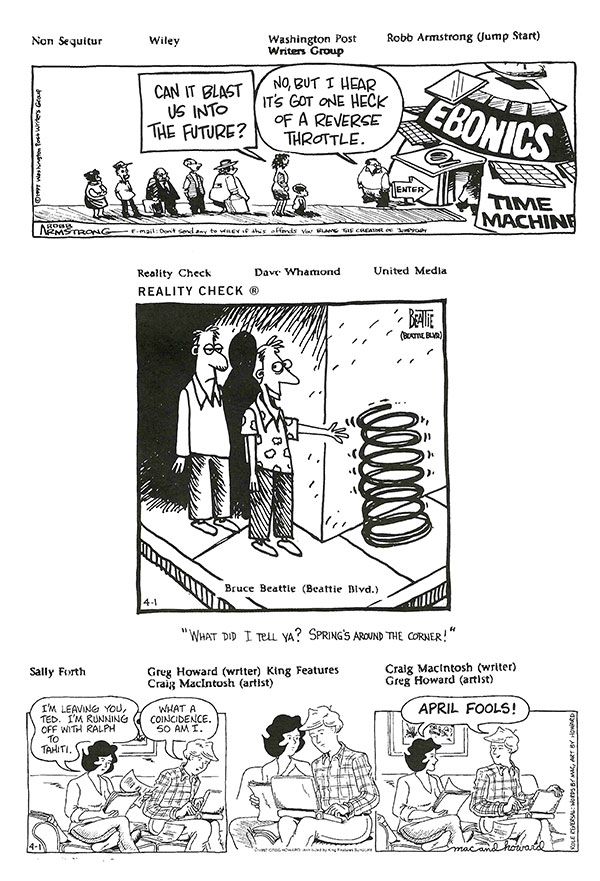 |
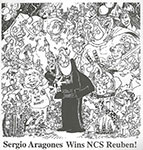 Nothing better
to close this rapture than Sergio Aragones, who, in that self-same year
of 1997received the National Cartoonists Society’s highest honor, the Reuben
trophy as “cartoonist of the year” at the 51st annual NCS
convention, held that year in Ashville, NC. Jud Hurd persuaded Sergio to
remember the event with a drawing that appeared on the cover of Cartoonist
PROfiles. And we’re delighted to have an excuse to post that drawing (one
of Sergio’s most elaborately intricate hysterical productions) here. How many
of Sergio’s characters can you identify?
Nothing better
to close this rapture than Sergio Aragones, who, in that self-same year
of 1997received the National Cartoonists Society’s highest honor, the Reuben
trophy as “cartoonist of the year” at the 51st annual NCS
convention, held that year in Ashville, NC. Jud Hurd persuaded Sergio to
remember the event with a drawing that appeared on the cover of Cartoonist
PROfiles. And we’re delighted to have an excuse to post that drawing (one
of Sergio’s most elaborately intricate hysterical productions) here. How many
of Sergio’s characters can you identify?
